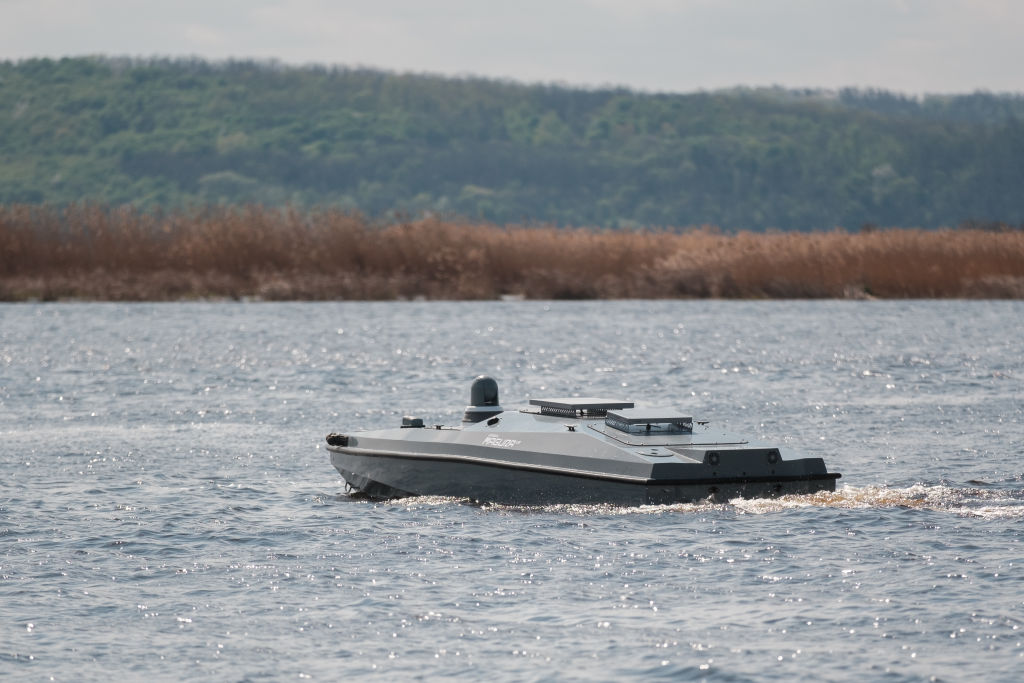In the wake of the success of aerial drones, naval forces are exploring ways to use uncrewed surface vessels to address maritime threats.
The drone ships, also known as USVs, can be as small as a meter or as large as 100 meters and are controlled by operators on land or navigate autonomously using sensors. They have clear advantages over traditional vessels: They are cheaper, operate in all weather and don’t put Sailors at risk.
“These advances have turned USVs into a genuine force multiplier,” Matthew Ratsey of the company Zero USV told South Africa’s Engineering News. “They extend the reach of maritime forces, enabling missions over larger areas without ports, offshore energy platforms and subsea cables, providing round-the-clock surveillance and real-time threat detection.”
Cutting-edge USVs include sensor suites with cameras, sonar, radar and acoustic systems to give operators a complete picture of the environment. Some are equipped with AI-enabled decision-making that can process the data they collect and instantly identify problems or threats. Communications systems allow for seamless data sharing with command centers, Engineering News reported.
The private sector is already using USVs to monitor ports, oil and gas installations and offshore wind farms. National navies believe the vessels can be equally useful for taking on illegal fishing, trafficking and other threats.
“More nations now consider USVs essential for enhancing surveillance, deterring piracy and conducting intelligence-gathering missions,” Ratsey said.
The military value of USVs has been on display in the conflict between Ukraine and Russia. Ukraine, which does not have warships, is countering Russian attacks in the Black Sea primarily using maritime drones. Ukraine deploys a domestically produced vessel known as the Magura V5 for surveillance, reconnaissance, mine warfare and kamikaze attacks.
Viktor Lystopadov, regional director of Ukraine’s SpetsTechnoExport, told defenceWeb that the USVs have changed the rules of modern conflict. He said his country has been able to destroy more than 20 Russian vessels valued at $2 billion using sea drones that cost a small fraction of that. Last year, a Ukrainian USV shot down a Russian Mi-8 helicopter, he said, which is believed to be the first instance of a USV downing a piloted aircraft.
“Today we almost cover all the area of the Black Sea with our drones,” he told defenceWeb. “This is a new type of war we have in Ukraine … we improve every day.”
Some African countries are making strides in the use of USVs.
- In South Africa, shipbuilder Legacy Marine is building a 9.5-meter vessel that uses AI and robotics to navigate. It is believed to be the first USV fully built and tested in South Africa.
- The Nigerian Navy acquired two SwiftSea Stalker USVs from U.S. manufacturer Swiftship. The vessels, with a range of 400 nautical miles and a speed of 45 knots, are expected to be used in the Niger Delta, Lake Chad and other difficult-to-patrol waterways.
- Last year, at Obangame Express, West Africa’s largest maritime exercise, the U.S. Navy deployed an autonomous underwater and surface vehicle known as TRITON. The 4.4-meter vessel can submerge for up to eight days and may be useful for African navies in the future, exercise organizers said.
Given that many coastal African nations have sprawling maritime domains to patrol and limited means, some observers believe the time is right to invest in aerial, surface and underwater drones.
“Securing Africa’s maritime seascape is a major undertaking,” wrote Denys Reva of the Institute for Security Studies. “Most states lack sufficient capacity to act on surveillance, either to deter or to apprehend potential offenders. Because they are affordable and relatively easy to deploy, drones can assist navies and coastguards.”

